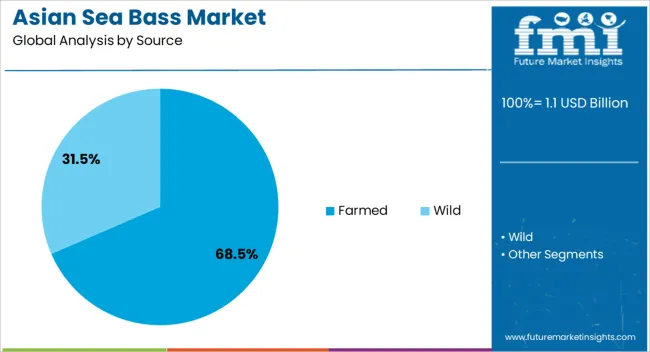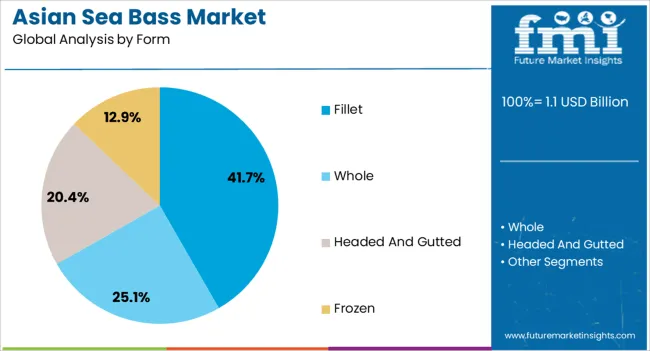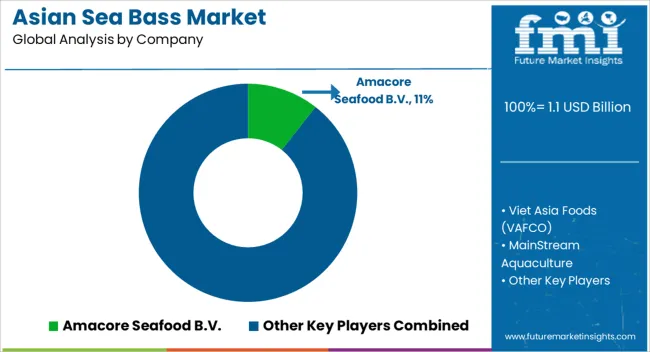The Asian Sea Bass Market is estimated to be valued at USD 1.1 billion in 2025 and is projected to reach USD 1.6 billion by 2035, registering a compound annual growth rate (CAGR) of 4.5% over the forecast period.

| Metric | Value |
|---|---|
| Asian Sea Bass Market Estimated Value in (2025 E) | USD 1.1 billion |
| Asian Sea Bass Market Forecast Value in (2035 F) | USD 1.6 billion |
| Forecast CAGR (2025 to 2035) | 4.5% |
The Asian sea bass market is expanding steadily, fueled by rising global demand for high-value seafood and the increasing role of aquaculture in meeting consumption needs. Industry reports, trade publications, and fisheries organization updates have highlighted strong consumer preference for Asian sea bass due to its mild flavor, nutritional profile, and versatility in culinary applications.
Farmed production has gained momentum as wild catch volumes face sustainability pressures, with governments and industry stakeholders promoting aquaculture as a reliable supply source. Investments in hatchery technologies, feed innovations, and disease management practices have improved yields and reduced operational risks.
At the same time, consumer purchasing behavior has shifted toward value-added products such as fillets, which cater to convenience-driven lifestyles. Expanding retail networks, supported by cold-chain logistics and modern distribution systems, have enhanced product availability across developed and emerging markets. Future market growth is expected to be underpinned by sustainability certifications, technological integration in aquaculture systems, and the expansion of retail seafood categories targeting health-conscious and premium food segments.

The Farmed segment is projected to account for 68.5% of the Asian sea bass market revenue in 2025, securing its leadership due to the scalability and reliability of aquaculture production. Growth in this segment has been supported by the declining availability of wild-caught fish and the increasing adoption of sustainable farming practices.
Hatchery advancements and selective breeding programs have strengthened productivity, ensuring consistent supply for both domestic and export markets. Farmed production has also benefited from regulatory frameworks that encourage aquaculture investments to reduce pressure on marine ecosystems.
Furthermore, farmed Asian sea bass ensures predictable quality and year-round availability, which aligns with the requirements of international trade and food service operators. These factors have collectively reinforced the dominance of the Farmed segment in the global market.

The Fillet segment is projected to hold 41.7% of the Asian sea bass market revenue in 2025, making it the leading form category. Demand for filleted fish has been driven by consumer preference for ready-to-cook, portion-controlled products that save time and minimize waste.
Food service operators and retailers have increasingly favored fillets due to their consistent quality, ease of preparation, and suitability for diverse culinary applications. Advances in processing and packaging technologies have enhanced shelf life and ensured food safety, strengthening consumer confidence in filleted products.
Additionally, rising urbanization and the growth of modern retail formats have supported the availability of fillets, particularly in frozen and chilled categories. With consumer lifestyles favoring convenience and premium seafood experiences, the Fillet segment is expected to maintain its leadership in the market.

The Retail Sales segment is projected to contribute 52.3% of the Asian sea bass market revenue in 2025, sustaining its role as the primary distribution channel. Retail growth has been supported by the expansion of supermarkets, hypermarkets, and specialty seafood stores, which provide consumers with access to a wide range of fresh and processed fish products.
Cold-chain infrastructure development has ensured consistent product quality in retail environments, while promotional campaigns have raised consumer awareness of Asian sea bass as a healthy protein source. Retailers have also capitalized on consumer trends toward premium and sustainably sourced seafood by offering certified farmed products.
Furthermore, the rise of e-commerce platforms and online grocery channels has broadened retail reach, particularly in urban centers where convenience and variety drive purchasing decisions. These dynamics have positioned retail sales as the dominant channel in the Asian sea bass market.
Technological innovations in the area of Asian sea bass farming have led to improvements in production efficiency, environmental impact reduction, and overall fish health. A CAGR of 5.3% was observed between 2020 and 2025 for Asian sea bass market.
Biological sensing technologies like the Environmental Sample Processor are used in the field to collect and analyze water samples. A DNA-based technology is used to identify tiny species of plankton to improve marine environment monitoring and management.
Help of modern software and technology in sea bass aquaculture uses precision cultivation techniques. A variety of surface and underwater cameras, data collection tools, and analysis methods can be employed to optimize the feeding and distribution rates to optimize performance.
Onshore, for example, recirculating aquaculture systems provide a sustainable fish farming method that solves environmental problems. Sea bass farming has undergone further technological advancements since Aquabounty Technologies introduced genetically modified salmon.
Onshore fishing systems would be enhanced by a fish farm located in this area, facilitating the decision to locate the fish farm. A CAGR of 4.5% is predicted between 2025 and 2035.
| Historical CAGR from 2020 to 2025 | 5.3% |
|---|---|
| Asian Sea Bass Market Forecast CAGR from 2025 to 2035 | 4.5% |
As seafood consumption increases over time, Asian sea bass consumption will also increase. Organic sea bass is driving a large portion of the growth of the sea bass market worldwide.
Due to increased awareness of the risks associated with synthetic fertilizers, insecticides, and pesticides, people have become more interested in organically grown food, especially sea bass. In order to optimize the nutritional content of organic sea bass, initiatives are being taken to improve the composition of organic feed and feed ingredients.
Several technological advances in sea bass farming have resulted in increased fish health, sustainability, and production efficiency. Focus on closed systems, genetic modifications, precision farming, and recirculating aquaculture systems (RAS) will drive the market. As a result of these technological advancements, the sea bass market is expanding.
Its nutritional value, including proteins, vitamins, and essential omega-3 fatty acids in Asian sea bass, makes it a popular food among customers. Sea bass' growing popularity as a snack and main dish has increased its demand.
Water quality, temperature swings, and disease outbreaks are affecting Asian sea bass aquaculture. Several government regulations may affect Asian sea bass supply chains, including fishing limits, aquaculture methods, and food safety regulations.
Competitors in both local and international markets may affect Asian sea bass demand. Alternatives protein sources or fish species, which provides comparable nutritional benefits at a lower price are available in the market
The following table shows the adoption rates of Asian sea bass in different countries. Applications of Asian sea bass products in culinary and foodservice sectors have grown significantly. Innovation and technology advancements in Asian sea bass farming will support market growth.
Forecasts indicate growth in the United Kingdom, Germany, India, China, and Japan. Europe will have a significant impact on the global economy. The Asia Pacific region accounts for a significant portion of the market size.
| Countries | Forecast CAGRs from 2025 to 2035 |
|---|---|
| Japan | 6.6% |
| China | 3.4% |
| India | 4.2% |
| Germany | 7.6% |
| United Kingdom | 9.3% |
Seafood is becoming increasingly popular among customers as a sustainable and healthy source of protein. Its mild flavor and firm texture make it a perfect choice for health-conscious customers looking for a delicious and nutritious alternative to supper. A CAGR of 9.3% is expected from the United Kingdom over the next ten years.
Increasing demand for Asian-inspired meals has further enhanced Asian sea bass's appeal in the United Kingdom market. Sustainable and ethical sourcing practices are also highly influential on customers' purchasing decisions. By 2025, the market is estimated to hold 3.1% of the market.
Increasing demand for responsibly harvested Asian sea bass is attributed to consumers' preference for seafood from certified and environmentally sustainable fisheries. Food diversity in the United Kingdom encourages culinary diversity, which further propels market expansion.
Consumers' preferences for healthy foods and a variety of seafood products are driving the growing demand for seafood products in the industry. In search of high-end seafood selections, German consumers are attracted to Asian sea bass's mild flavor and variety of culinary uses. It is estimated that the market will expand at a CAGR of 7.6% over the next few decades.
In addition, German consumers are becoming more eco-conscious and ethical in their purchasing decisions. Authentic Asian sea bass is in high demand from customers who prefer products from trusted fisheries that adhere to ethical and environmental standards. Tourism is expected to grow in the future, which will present market opportunities for businesses.
Asian sea bass markets are expected to expand at the fastest rate in the upcoming years. A 4.2% CAGR is expected from India during the forecast period. A huge fishing industry and a growing need for products made from Asian sea bass farming are the primary factors driving Asian sea bass demand in India. An estimated 18.4% market share is expected by 2025.
As the Indian aquaculture industry emphasizes ethical farming practices and uses saline areas for aquaculture, it is expected to contribute significantly to the expansion of the Asian sea bass market. Increasing seafood production and consumption capacities in India will lead to a dramatic increase in the nation's market value for Asian sea bass.
China is expected to be a lucrative market for the Asian sea bass market. In the Asian sea bass market, China is home to over 75% of farms that are recognized by Best Aquaculture Practices (BAP).
Developing countries in Asia have become leaders in fish production due to the nutritional value of Asian sea bass. The market is predicted to hold a market share of 21.1% by 2025.
Over 75% of the BAP-certified farms in China are located on 200,000 hectares of land that are suitable for seabass farming. Seabass is particularly well-suited to the aquaculture zones of Guangdong, Guangxi, and Hainan. As a result of an increase in international trade and the widespread availability of Asian sea bass in China, Asian sea bass are also driving demand in the country.
Asian sea bass is expected to be the fastest-growing market in Japan in the near future. Japan is predicted to account for a 6.6% CAGR between 2025 and 2035. A 15.4% share of the market is expected to be recorded during the forecast period.
Asian sea bass, or Suzuki, is a popular fish in Japan. Due to the deep culture of seafood in Japan, especially in coastal areas and major cities like Tokyo and Osaka, fresh Asian sea bass is always in demand in Japanese markets. It is widely used in Japanese cuisine, especially grilled food, sushi, and sashimi.
Bass fishing has become more popular in Japan due to improved fishing equipment and social media trends. Markets and cultures have changed dramatically, and with drop-shotting in particular becoming more popular, specialist tackle has become more important than ever. All these factors are driving demand for the Asian sea bass market in Japan.
The following segment provides detailed information on the leading segment. According to the source, the framed segment is expected to hold 45% of the market in 2025. Based on the form, 25% of the market share is expected in 2025 for the whole segment.
| Category | Market Share 2025 |
|---|---|
| Framed | 45% |
| Whole | 25% |
Based on source, the framed segment is expected to drive the Asian sea bass market demand. With framed sourcing, sustainable techniques are strongly emphasized to protect marine ecosystems and guarantee Asian sea bass' long-term survival. With consumers becoming more concerned about the impact of seafood on the environment, sustainable sourcing can attract this expanding market sector.
Asian sea bass origins can be better traced through framed sourcing, which provides comprehensive information about where and how it was farmed. By assuring ethical shoppers of the product's purity and quality, this openness fosters consumer confidence in the brand.
Regulatory requirements for sustainable seafood may be met through structured sourcing. By adopting sustainable practices and transparency in supply chains, companies can maintain access to important markets.
By form, the whole segment will have a higher consumption share than other segments. A whole farm approach maintains quality throughout the entire production process, from hatchery to harvest.
Sustainability strategies like reducing waste, improving resource efficiency, and reducing environmental impact could attract environmentally conscious consumers willing to pay more for ethically produced seafood. Asian sea bass may increase demand and broaden its market by educating customers about its health benefits, gastronomic adaptability, and sustainability.

Key players in the Asian sea bass industry strive to expand their business through mergers and acquisitions. Research and development on Asian sea bass is being undertaken by major producers. Developing farming techniques that increase yields and nutritional content is the goal of research and development. The impact of economic factors on the Asian sea bass market will drive demand.
| Attributes | Details |
|---|---|
| Estimated Market Size in 2025 | USD 1,012 million |
| Projected Market Valuation in 2035 | USD 1,567 million |
| Value-based CAGR 2025 to 2035 | 4.5% |
| Forecast Period | 2025 to 2035 |
| Historical Data Available for | 2020 to 2025 |
| Market Analysis | Value in USD million |
| Key Regions Covered | North America; Latin America; Western Europe; Eastern Europe; South Asia; East Asia; The Middle East and Africa |
| Key Market Segments Covered | Source, Form, Sales Channel, Region |
| Key Countries Profiled | The United States, Canada, Brazil, Mexico, Germany, United Kingdom, France, Spain, Italy, Poland, Russia, Czech Republic, Romania, India, Bangladesh, Australia, New Zealand, China, Japan, South Korea, GCC Countries, South Africa, Israel |
| Key Companies Profiled | Amacore Seafood B.V.; Viet Asia Foods (VAFCO); MainStream Aquaculture; Shwe Yamone Manufacturing Co. Ltd.; A.O. Kingdom International Co. Ltd.; Nghi Son Aquatic Product Exim Co. Ltd; Oceanpick Pvt. Ltd; Barramundi Group; Allegro Aqua; Mattes Seafood; Ocean Treasure |
Market segments include farmed (freshwater, brakishwater) and wild.
Key sourcing data is in the report, such as whole, headed and gutted, fillet, and frozen.
Formats are further divided into direct sales-B2B and retail sales (modern trade, convenience store, specialty food stores, online retail, and other).
The market has been analyzed in the major markets of North America, Latin America, Western Europe, South Asia, East Asia, Eastern Europe, and Middle East & Africa.
The global asian sea bass market is estimated to be valued at USD 1.1 billion in 2025.
The market size for the asian sea bass market is projected to reach USD 1.6 billion by 2035.
The asian sea bass market is expected to grow at a 4.5% CAGR between 2025 and 2035.
The key product types in asian sea bass market are farmed, _freshwater, _brackish water and wild.
In terms of form, fillet segment to command 41.7% share in the asian sea bass market in 2025.






Full Research Suite comprises of:
Market outlook & trends analysis
Interviews & case studies
Strategic recommendations
Vendor profiles & capabilities analysis
5-year forecasts
8 regions and 60+ country-level data splits
Market segment data splits
12 months of continuous data updates
DELIVERED AS:
PDF EXCEL ONLINE
Vegan Asian Food Market Analysis by Alternatives, Distribution Channel, and Region Through 2035
Seat Control Module (SCM) Market Forecast and Outlook 2025 to 2035
Seafood Farming Chillers Market Forecast and Outlook 2025 to 2035
Sealing & Strapping Packaging Tape Market Size and Share Forecast Outlook 2025 to 2035
Search and Rescue Equipment (SAR) Market Size and Share Forecast Outlook 2025 to 2035
Seaport Security Management Market Size and Share Forecast Outlook 2025 to 2035
Seaweed Extracts Market Size and Share Forecast Outlook 2025 to 2035
Sealing Agent for Gold Market Size and Share Forecast Outlook 2025 to 2035
Sealant Web Film Market Size and Share Forecast Outlook 2025 to 2035
Sea Enzyme Products Market Size and Share Forecast Outlook 2025 to 2035
Seasonal Allergy Market Size and Share Forecast Outlook 2025 to 2035
Seaweed-Based Anti-Aging Ingredients Market Size and Share Forecast Outlook 2025 to 2035
Sea Buckthorn Actives Market Size and Share Forecast Outlook 2025 to 2035
Seaweed Derived Minerals Market Size and Share Forecast Outlook 2025 to 2035
Seasoning Market Size and Share Forecast Outlook 2025 to 2035
Seating And Positioning Belts Market Size and Share Forecast Outlook 2025 to 2035
Sea Air Logistics Market Size and Share Forecast Outlook 2025 to 2035
Seafood Packaging Market Size and Share Forecast Outlook 2025 to 2035
Seafood Takeout Market Size and Share Forecast Outlook 2025 to 2035
Sealed Wax Packaging Market Size and Share Forecast Outlook 2025 to 2035

Thank you!
You will receive an email from our Business Development Manager. Please be sure to check your SPAM/JUNK folder too.
Chat With
MaRIA